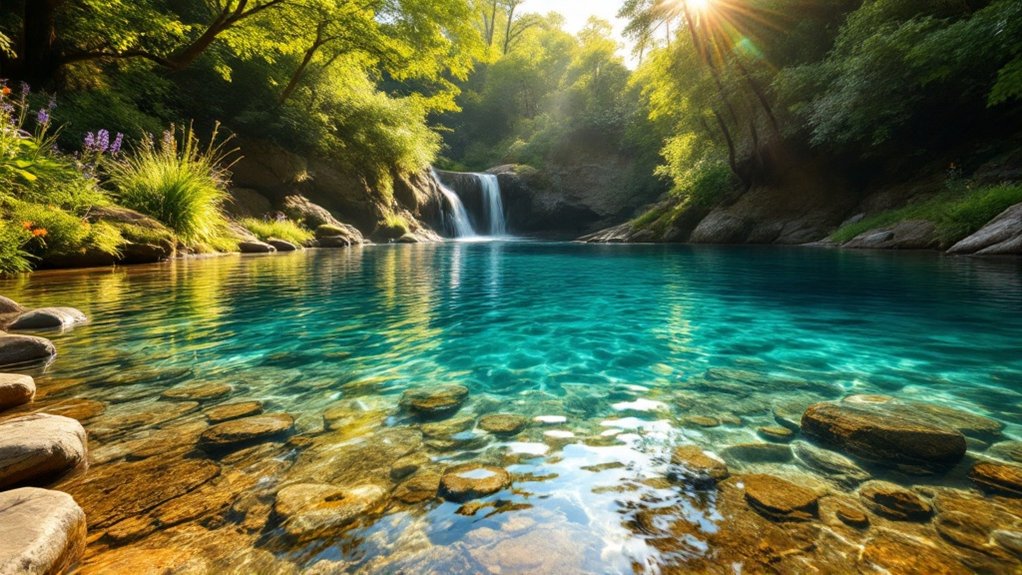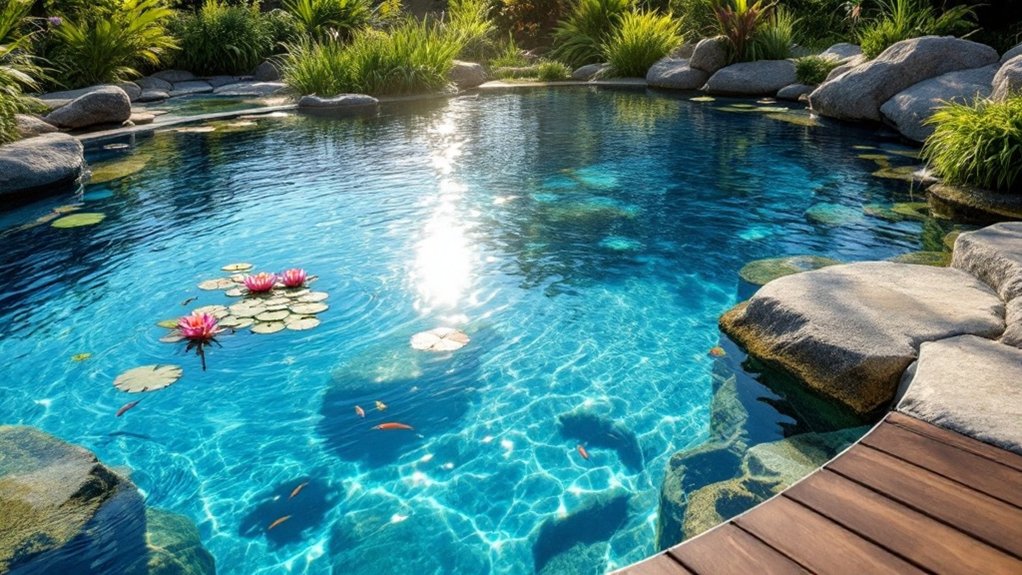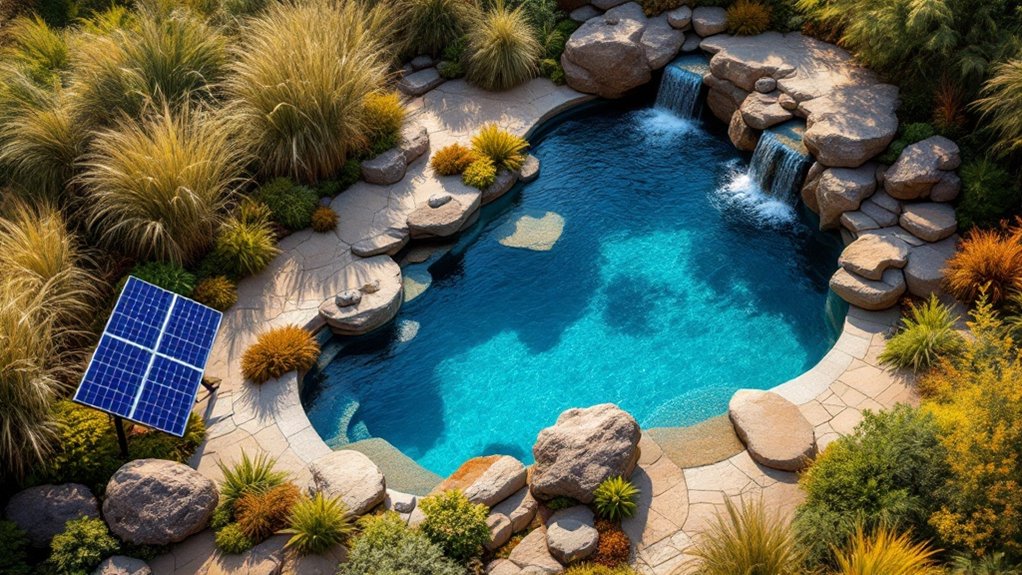Natural pools present a unique solution for those seeking an eco-friendly swimming experience. By employing natural filtration methods, these pools offer clarity without the use of harsh chemicals. Their design not only enhances aesthetic appeal but also fosters biodiversity. However, the implementation of such pools requires careful planning and examination. What are the essential factors to examine when designing a natural pool? Understanding these elements can lead to a more sustainable and enjoyable swimming environment.
Understanding Natural Pools
While traditional swimming pools rely on chemical treatments to maintain water clarity, natural pools offer an eco-friendly alternative that utilizes biological filtration systems. These pools typically integrate plants, gravel, and microorganisms to create a self-sustaining ecosystem. The design of a natural pool often features two zones: a swimming area and a regeneration zone, where aquatic plants filter and purify the water. This process not only reduces the need for synthetic chemicals but also fosters biodiversity, creating habitats for various species. Additionally, natural pools can be aesthetically pleasing, blending seamlessly into their surroundings. They vary in size and shape, allowing for customization to fit different landscapes and preferences, promoting a more harmonious relationship between humans and nature.
Benefits of Natural Swimming Pools
Natural swimming pools offer significant advantages, particularly in their eco-friendly water filtration systems that eliminate the need for harsh chemicals. This natural approach not only benefits the environment but also provides a healthier swimming experience for users. By promoting a cleaner and more sustainable way to enjoy water, these pools stand out as an appealing alternative to traditional options.
Eco-Friendly Water Filtration
Many homeowners are increasingly drawn to the concept of eco-friendly water filtration systems found in natural swimming pools. Unlike traditional pools that rely on harsh chemicals, these systems utilize biological filters and plant life to maintain water clarity and quality. The integration of aquatic plants not only purifies the water but also creates a balanced ecosystem that supports biodiversity. This natural approach minimizes the environmental impact, as it reduces chemical runoff and conserves water through efficient filtration processes. Additionally, these systems require less energy to operate, contributing to lower utility bills. Homeowners appreciate the aesthetic appeal of lush greenery surrounding the pool, enhancing the overall outdoor experience while promoting a sustainable lifestyle.
Healthier Swimming Experience
Choosing a natural swimming pool offers a healthier swimming experience due to the absence of harsh chemicals typically found in conventional pools. This chemical-free environment minimizes skin irritations and allergic reactions, making it suitable for individuals with sensitivities. Natural pools use biological filtration systems, which promote a balanced ecosystem, ensuring cleaner water without synthetic additives. Additionally, the presence of aquatic plants not only enhances water clarity but also contributes to oxygenation, creating a revitalizing ambiance. Swimmers can enjoy the benefits of natural minerals and organic compounds that improve skin health and overall well-being. Ultimately, natural swimming pools provide a serene and rejuvenating experience, aligning with a holistic approach to health and wellness while fostering a deeper connection with nature.
Key Design Considerations
When designing a natural pool, key considerations include site selection and orientation, which influence sunlight exposure and water temperature. Additionally, careful plant selection and placement play an essential role in maintaining ecological balance. Finally, effective filtration and circulation systems are vital for ensuring water quality and clarity.
Site Selection and Orientation
Site selection and orientation are critical components in the design of natural pools, greatly influencing their functionality and aesthetic appeal. The chosen site should have adequate space to accommodate both the swimming area and surrounding landscape features. It is essential to evaluate sunlight exposure; pools benefit from full sun during the day to maintain water temperature and promote healthy biological activity. Additionally, proximity to existing structures can enhance convenience but may also introduce shading or runoff issues. A well-drained area minimizes waterlogging and promotes clearer water quality. Moreover, considering wind patterns can help in orienting the pool to minimize debris accumulation and evaporation. Overall, careful site selection and orientation lay the groundwork for a sustainable and enjoyable natural swimming experience.
Plant Selection and Placement
The selection and placement of plants play a pivotal role in the overall design and functionality of natural pools. Choosing native aquatic plants enhances the ecosystem, providing habitat for wildlife while promoting biodiversity. It is crucial to take into account the specific needs of each plant, such as light, water depth, and temperature, to guarantee healthy growth. Strategic placement around the pool’s perimeter can create natural filtration zones, which help maintain water clarity and reduce algae. Additionally, incorporating a variety of plant heights and textures adds visual interest and creates a more inviting atmosphere. Properly designed plant beds not only enhance aesthetics but also support the ecological balance, contributing to the sustainability of the natural pool environment.
Filtration and Circulation Systems
Effective filtration and circulation systems are essential components in the design of natural pools, greatly influencing water quality and clarity. These systems typically integrate biological filtration, which utilizes beneficial bacteria and aquatic plants to break down organic matter and maintain a balanced ecosystem. Proper circulation guarantees that water flows evenly throughout the pool, preventing stagnation and promoting even nutrient distribution. Key design considerations include the size and depth of the pool, the selection of appropriate pumps, and the placement of filtration zones. Additionally, incorporating natural features such as waterfalls or streams can enhance aeration and aesthetic appeal. Ultimately, a well-designed filtration and circulation system sustains a healthy aquatic environment, securing a safe and enjoyable swimming experience.
Choosing the Right Location
When selecting a location for a natural pool, it is vital to take into account both environmental factors and personal preferences. The site should ideally have access to sunlight, as this promotes the growth of aquatic plants essential for filtration. Additionally, it is important to assess the soil type; sandy or loamy soils are preferable for drainage. Proximity to existing landscaping can enhance the aesthetic appeal, while also providing natural shade. Moreover, potential water sources, such as nearby streams or rainwater collection, should be considered to maintain water levels. Finally, local zoning regulations and property boundaries must be reviewed to guarantee compliance and avoid disturbances to neighbors. Careful planning will lead to a sustainable and harmonious natural pool environment.
Types of Natural Filtration Systems
Natural filtration systems play an essential role in maintaining the health and clarity of a natural pool, as they utilize a combination of biological, physical, and chemical processes. There are several types of natural filtration systems, each designed to promote water quality in distinct ways. The most common types include gravel and sand filters, which physically remove debris while fostering beneficial microorganisms. Biofiltration systems employ aquatic plants that absorb nutrients and provide habitat for microorganisms, enhancing purification. Additionally, constructed wetlands can filter water through layers of soil and vegetation, mimicking natural ecosystems. Each system contributes to the overall balance of the pool, ensuring a clean swimming environment without the use of harsh chemicals. This approach aligns with sustainable swimming practices.
Enhancing Biodiversity in Your Pool
Enhancing biodiversity in a natural pool creates a vibrant ecosystem that benefits both aquatic life and human users. Incorporating native plants is essential, as they provide habitats, food, and improve water quality. Species such as reeds, lilies, and sedges can attract beneficial insects and amphibians, fostering a balanced environment. Additionally, introducing fish species like minnows can help control algae growth while enhancing the pool’s aesthetic appeal. Creating varied depths and structures within the pool encourages different organisms to thrive. Installing natural filtration systems, such as gravel beds and biofilters, supports microbial life that aids in nutrient cycling. Ultimately, promoting biodiversity not only enriches the pool’s ecological health but also creates a serene and enjoyable space for swimming and relaxation.
Maintenance Tips for Natural Pools
Regular maintenance is essential for keeping a natural pool in ideal condition. Routine tasks include monitoring water levels and quality, guaranteeing that the filtration system functions at peak performance. Regular removal of debris, such as leaves and twigs, helps prevent clogging and maintains water clarity. Additionally, it is important to check and maintain the health of aquatic plants, as they play a significant role in filtration and ecological balance. Seasonal adjustments, including winterizing the pool and managing algae growth during warmer months, are necessary for long-term sustainability. Regularly inspecting the surrounding landscape for invasive species will also help preserve biodiversity. By adhering to these maintenance tips, pool owners can guarantee their natural pools remain inviting and ecologically sound throughout the swimming season.
Cost Considerations and Budgeting
When planning for a natural pool, understanding the associated costs is essential for effective budgeting. Initial expenses typically include site preparation, excavation, and the installation of filtration systems, which can vary considerably based on location and design. Natural pools often require more upfront investment than traditional pools due to the unique materials and ecosystems involved. Homeowners should also consider ongoing costs, such as maintenance, water testing, and potential landscaping enhancements. Additionally, energy-efficient systems can help reduce long-term operational costs. It is advisable to create a detailed budget that accommodates both initial and recurring expenses while allowing for potential unexpected costs. This thoughtful approach guarantees that the natural pool remains a sustainable and enjoyable investment over time.
Inspiring Natural Pool Designs
Natural pool designs offer a harmonious blend of aesthetics and functionality, drawing inspiration from nature to create tranquil, eco-friendly swimming environments. These pools often incorporate natural materials like stone and wood, enhancing their integration with the surrounding landscape. Designs can feature lush aquatic plants that not only purify the water but also provide habitat for wildlife. Curvilinear shapes mimic natural bodies of water, while varying depths create visual interest and cater to diverse swimming preferences. Lighting elements can be strategically placed to highlight the pool’s features at night, transforming the space into a serene retreat. By embracing sustainable practices, these designs not only promote relaxation but also foster a deeper connection with the environment.
Frequently Asked Questions
Can I Swim in a Natural Pool During Winter?
Swimming in a natural pool during winter is generally not advisable due to cold temperatures, which can pose health risks. However, some individuals may enjoy the experience if properly prepared and equipped for the chilly conditions.
Are There Any Safety Concerns With Natural Pools?
Safety concerns with natural pools can include water quality, potential for slippery surfaces, and the presence of wildlife. Regular maintenance and monitoring are crucial to mitigate risks and guarantee a safe swimming environment for users.
How Do Natural Pools Affect Local Wildlife?
Natural pools can positively impact local wildlife by providing habitats for various species, including amphibians and aquatic plants. However, they may also disrupt existing ecosystems if not designed with ecological considerations, potentially affecting local biodiversity adversely.
Can I Use Chemicals in a Natural Pool?
The use of chemicals in a natural pool can disrupt its ecosystem. While some may consider minor treatments, it is generally advised to rely on natural filtration methods to maintain water quality and protect local wildlife.
What Plants Are Best for Natural Pool Landscaping?
The best plants for natural pool landscaping include native aquatic species, such as water lilies and cattails, alongside marginal plants like ferns and ornamental grasses. These selections enhance biodiversity while providing aesthetic appeal and natural filtration.
Conclusion
Natural pools present an innovative approach to swimming that harmonizes human enjoyment with ecological sustainability. By utilizing natural filtration methods and promoting biodiversity, these pools not only enhance the aesthetic value of outdoor spaces but also contribute to environmental health. With thoughtful design, careful site selection, and ongoing maintenance, natural pools offer a rejuvenating alternative to conventional swimming facilities. Embracing this eco-friendly option fosters a deeper connection with nature while providing a safe and enjoyable swimming experience.




